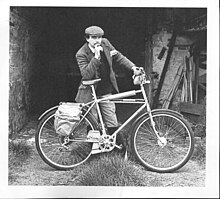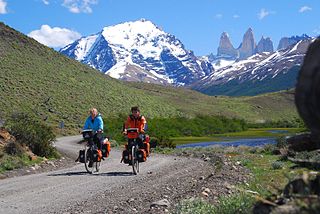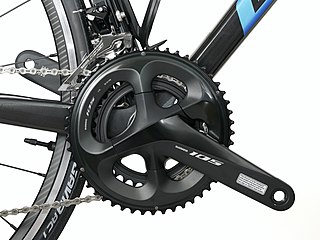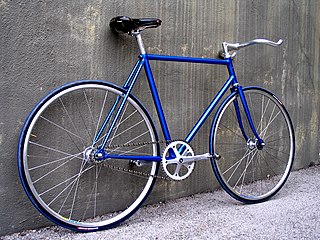Geoff Apps | |
|---|---|
 Apps with one of his 'Range Rider' off-road cycles | |
| Born | Geoffrey Cleland Apps 1949 |
| Nationality | British |
Geoffrey Cleland Apps (born London, England, 1949) is an English pioneer of all-terrain bicycles.
Geoff Apps | |
|---|---|
 Apps with one of his 'Range Rider' off-road cycles | |
| Born | Geoffrey Cleland Apps 1949 |
| Nationality | British |
Geoffrey Cleland Apps (born London, England, 1949) is an English pioneer of all-terrain bicycles.
Geoff Apps' family moved near the Chiltern Hills north-west of London, where he cycled in the woods. He took up motorcycle observed trials riding but was unhappy with the noise and disturbance.
He began modifying conventional bicycles for off-road use in 1965. By 1979 he had designed and created a lightweight bicycle for the wet mud of south-east England that used 650Bx54 Nokia Hakkapeliitta snow tyres from Finland. Apps set up Cleland Cycles Ltd to manufacture copies of his Aventura design in 1982 and these were sold under Apps' Cleland Cycles brand until 1984. They were designed for touring, in which reliability and comfort were more important than speed and racing. [1] Companies in Britain produced their own versions, notably English Cycles and Highpath Engineering.
The Range-Rider had a number of interesting features. The frame was built with Reynolds 531 butted tubing throughout including the extra diagonal brace from the top of the seat tube to the bottom of the head tube. The extra wide bottom bracket featured needle roller bearings and flat thrust bearings rather than traditional ball-bearing cup design. Double chainrings and outer guard ring with 5 rear sprockets gave a wide range with a low ratio 20.6” gear which with the tungsten carbide studded Hakka tyres allowed riders to climb extreme gradients. In October 1981 a Range-Rider was ridden up Snowdon, the highest mountain in Wales. A bash plate and mud guard protected the chainrings. Hub brakes were fitted to overcome any effects of mud and water on rim brakes. Mudguards were modified to have the brackets on the outside to reduce mud buildup. Spoke holes in the rims were drilled out to accept heavy-duty spoke 12-gauge spokes. With tyre pressures lowered the ride off-road was extraordinary with grip and traction levels better than many riders could exploit. On the road, with the Hakkas pumped up hard, the ride was noisy but wonderful on ice. With less extreme tyres it felt quicker and gave a confidence-inspiring ride with the stiff light frame. [2]
Apps read about the Ritchey-built MountainBikes mountain bike in the February 1980 BMX Plus and contacted Gary Fisher and Charlie Kelly at the MountainBikes Company in Fairfax, California. Apps told them about the off-road bicycles he had built and of large diameter 650Bx54 and 700Cx47 Nokia Hakkapeliitta snow tyres that were made in Finland. In December 2006, Fisher said of Apps’s 1980 contact: "We got some tires from Geoff Apps really early on and we said ‘Holy Toledo!’" But poor supply meant the fledgling MTB industry stuck with the smaller wheels. [3] [4]
Apps lives in Scotland where he continues to ride and develop bicycles. He cofounded and contributed to, Making Tracks before moving to Scotland to work on New Cyclist. He is an illustrator and draughtsman, his work appearing in publications including Bicycle Design.

A bicycle, also called a pedal cycle, bike, push-bike or cycle, is a human-powered or motor-assisted, pedal-driven, single-track vehicle, with two wheels attached to a frame, one behind the other. A bicycle rider is called a cyclist, or bicyclist.

A tandem bicycle or twin is a form of bicycle designed to be ridden by more than one person. The term tandem refers to the seating arrangement, not the number of riders. Patents related to tandem bicycles date from the mid 1880s. Tandems can reach higher speeds than the same riders on single bicycles, and tandem bicycle racing exists. As with bicycles for single riders, there are many variations that have been developed over the years.

A mountain bike (MTB) or mountain bicycle is a bicycle designed for off-road cycling. Mountain bikes share some similarities with other bicycles, but incorporate features designed to enhance durability and performance in rough terrain, which makes them heavier, more complex and less efficient on smooth surfaces. These typically include a suspension fork, large knobby tires, more durable wheels, more powerful brakes, straight, extra wide handlebars to improve balance and comfort over rough terrain, and wide-ratio gearing optimised for topography, application and a frame with a suspension mechanism for the rear wheel. Rear suspension is ubiquitous in heavier-duty bikes and now common even in lighter bikes. Dropper posts can be installed to allow the rider to quickly adjust the seat height.

Mountain biking is a sport of riding bicycles off-road, often over rough terrain, usually using specially designed mountain bikes. Mountain bikes share similarities with other bikes but incorporate features designed to enhance durability and performance in rough terrain, such as air or coil-sprung shocks used as suspension, larger and wider wheels and tires, stronger frame materials, and mechanically or hydraulically actuated disc brakes. Mountain biking can generally be broken down into five distinct categories: cross country, trail riding, all mountain, downhill, and freeride.

A derailleur is a variable-ratio bicycle gearing system consisting of a chain, multiple sprockets of different sizes, and a mechanism to move the chain from one sprocket to another.

Bicycle touring is the taking of self-contained cycling trips for pleasure, adventure or autonomy rather than sport, commuting or exercise. Bicycle touring can range from single-day trips to extended travels spanning weeks or months. Tours may be planned by the participant or organized by a tourism business, local club or organization, or a charity as a fund-raising venture.

The crankset or chainset is the component of a bicycle drivetrain that converts the reciprocating motion of the rider's legs into rotational motion used to drive the chain or belt, which in turn drives the rear wheel. It consists of one or more sprockets, also called chainrings or chainwheels attached to the cranks, arms, or crankarms to which the pedals attach. It is connected to the rider by the pedals, to the bicycle frame by the bottom bracket, and to the rear sprocket, cassette or freewheel via the chain.

A touring bicycle is a bicycle designed or modified to handle bicycle touring. To make the bikes sufficiently robust, comfortable and capable of carrying heavy loads, special features may include a long wheelbase, frame materials that favor flexibility over rigidity, heavy duty wheels, and multiple mounting points.

A utility bicycle, city bicycle, urban bicycle, European city bike (ECB), Dutch bike, classic bike or simply city-bike is a bicycle designed for frequent very short, very slow rides through very flat urban areas. It is a form of utility bicycle commonly seen around the world, built to facilitate everyday short-distance riding in normal clothes in cold-to-mild weather conditions. It is therefore a bicycle designed for very short-range practical transportation, as opposed to those primarily for recreation and competition, such as touring bicycles, racing bicycles, and mountain bicycles. Utility bicycles are the most common form globally, and comprise the vast majority found in the developing world. City bikes may be individually owned or operated as part of a public bike sharing scheme.

A racing bicycle, also known as a road bike is a bicycle designed for competitive road cycling, a sport governed by and according to the rules of the Union Cycliste Internationale (UCI).

Cyclo-cross is a form of bicycle racing. Races typically take place in the autumn and winter, and consist of many laps of a short course featuring pavement, wooded trails, grass, steep hills and obstacles requiring the rider to quickly dismount, carry the bike while navigating the obstruction and remount. Races for senior categories are generally between 40 minutes and an hour long, with the distance varying depending on the ground conditions. The sport is strongest in the traditional road cycling countries such as Belgium, France and the Netherlands.

A cyclo-cross bike or cyclo-cross bicycle is a bicycle specifically designed for the rigors of a cyclo-cross race. Cyclo-cross bicycles roughly resemble the racing bicycles used in road racing. The major differences between the two are the frame geometry, and the wider clearances that cyclo-cross bikes have for their larger tires and mud and other debris that they accumulate.

A single-speed bicycle is a type of bicycle with a single gear ratio. These bicycles are without derailleur gears, hub gearing or other methods for varying the gear ratio of the bicycle.

A fixed-gear bicycle is a bicycle that has a drivetrain with no freewheel mechanism such that the pedals always will spin together with the rear wheel. The freewheel was developed early in the history of bicycle design but the fixed-gear bicycle remained the standard track racing design. More recently the "fixie" has become a popular alternative among mainly urban cyclists, offering the advantage of simplicity compared with the standard multi-geared bicycle.
29ers or two-niners are mountain bikes and hybrid bikes that are built to use 700c or 622 mm ISO wheels, commonly called 29″ wheels. Most mountain bikes once used ISO 559 mm wheels, commonly called 26″ wheels. The ISO 622 mm wheel is typically also used for road-racing, trekking, cyclo-cross, touring and hybrid bicycles. In some countries, mainly in Continental Europe, ISO 622 mm wheels are commonly called 28″ wheels or "28 Incher".

Tom Ritchey is an American bicycle frame builder, Category 1 racer, fabricator, designer, and founder of Ritchey Design. Ritchey is a US pioneer in modern frame building and the first production mountain bike builder/manufacturer in the history of the sport. He is an innovator of bicycle components that have been used in winning some of the biggest cycling competitions in the world including the UCI World Championships, the Tour de France and the Olympics. In 1988, Ritchey was inducted into the inaugural Mountain Bike Hall of Fame in Crested Butte, Colorado : and 2012, inducted to the United States Bicycle Hall of Fame in Davis, California.

This is a glossary of terms and jargon used in cycling, mountain biking, and cycle sport.

Joe Breeze is an American bicycle framebuilder, designer and advocate from Marin County, California. An early participant in the sport of mountain biking, Breeze, along with other pioneers including Gary Fisher, Charlie Kelly, and Tom Ritchey, is known for his central role in developing the mountain bike. Breeze is credited with designing and building the first all-new mountain bikes, which riders colloquially called Breezers. He built the prototype, known as Breezer #1, in 1977 and completed nine more Series I Breezers by early 1978. Breezer #1 is now in the collection of the Smithsonian Institution’s National Museum of American History.

Gravel cycling, gravel biking or gravel grinding is a sport, or a leisure activity, in which participants ride bicycles mostly on gravel roads. Sometimes, specially designed gravel bikes are used; in other cases, any bicycle capable of covering the terrain can be used.